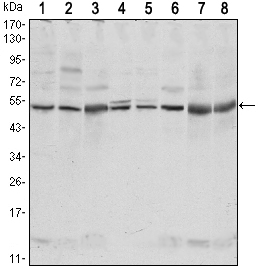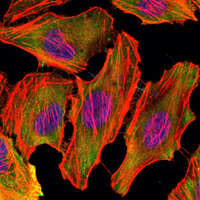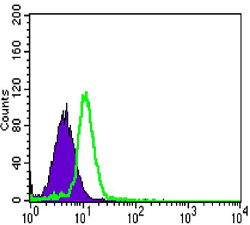Csk Monoclonal Antibody
- Catalog No.:YM0170
- Applications:WB;IF;FCM;ELISA
- Reactivity:Human;Mouse;Rat;Monkey
- Target:
- Csk
- Fields:
- >>Epithelial cell signaling in Helicobacter pylori infection
- Gene Name:
- CSK
- Protein Name:
- Tyrosine-protein kinase CSK
- Human Gene Id:
- 1445
- Human Swiss Prot No:
- P41240
- Mouse Gene Id:
- 12988
- Mouse Swiss Prot No:
- P41241
- Rat Gene Id:
- 315707
- Rat Swiss Prot No:
- P32577
- Immunogen:
- Purified recombinant fragment of human Csk expressed in E. Coli.
- Specificity:
- Csk Monoclonal Antibody detects endogenous levels of Csk protein.
- Formulation:
- Liquid in PBS containing 50% glycerol, 0.5% BSA and 0.02% sodium azide.
- Source:
- Monoclonal, Mouse
- Dilution:
- WB 1:500 - 1:2000. IF 1:200 - 1:1000. Flow cytometry: 1:200 - 1:400. ELISA: 1:10000. Not yet tested in other applications.
- Purification:
- Affinity purification
- Storage Stability:
- -15°C to -25°C/1 year(Do not lower than -25°C)
- Other Name:
- CSK;Tyrosine-protein kinase CSK;C-Src kinase;Protein-tyrosine kinase CYL
- Molecular Weight(Da):
- 51kD
- References:
- 1. Nat Genet. 2009 Jun;41(6):677-87.
2. Leuk Res. 2009 Sep;33(9):e168-9.
3. J Hypertens. 2011 Jan;29(1):62-9.
- Background:
- catalytic activity:ATP + a [protein]-L-tyrosine = ADP + a [protein]-L-tyrosine phosphate.,function:Specifically phosphorylates 'Tyr-504' on LCK, which acts as a negative regulatory site. Can also act on the LYN and FYN kinases.,PTM:Autophosphorylation of Tyr-304 occurs only at abnormally high CSK concentrations in vitro.,similarity:Belongs to the protein kinase superfamily. Tyr protein kinase family.,similarity:Belongs to the protein kinase superfamily. Tyr protein kinase family. CSK subfamily.,similarity:Contains 1 protein kinase domain.,similarity:Contains 1 SH2 domain.,similarity:Contains 1 SH3 domain.,subcellular location:Mainly cytoplasmic, also present in lipid rafts.,subunit:Interacts with PTPN8 (By similarity). Interacts with phosphorylated SIT1, PAG1, LIME1 and TGFB1I1.,tissue specificity:Expressed in lung and macrophages.,
- Function:
- catalytic activity:ATP + a [protein]-L-tyrosine = ADP + a [protein]-L-tyrosine phosphate.,function:Specifically phosphorylates 'Tyr-504' on LCK, which acts as a negative regulatory site. Can also act on the LYN and FYN kinases.,PTM:Autophosphorylation of Tyr-304 occurs only at abnormally high CSK concentrations in vitro.,similarity:Belongs to the protein kinase superfamily. Tyr protein kinase family.,similarity:Belongs to the protein kinase superfamily. Tyr protein kinase family. CSK subfamily.,similarity:Contains 1 protein kinase domain.,similarity:Contains 1 SH2 domain.,similarity:Contains 1 SH3 domain.,subcellular location:Mainly cytoplasmic, also present in lipid rafts.,subunit:Interacts with PTPN8 (By similarity). Interacts with phosphorylated SIT1, PAG1, LIME1 and TGFB1I1.,tissue specificity:Expressed in lung and macrophages.,
- Subcellular Location:
- Cytoplasm . Cell membrane . Mainly cytoplasmic, also present in lipid rafts. .
- Expression:
- Expressed in lung and macrophages.
- June 19-2018
- WESTERN IMMUNOBLOTTING PROTOCOL
- June 19-2018
- IMMUNOHISTOCHEMISTRY-PARAFFIN PROTOCOL
- June 19-2018
- IMMUNOFLUORESCENCE PROTOCOL
- September 08-2020
- FLOW-CYTOMEYRT-PROTOCOL
- May 20-2022
- Cell-Based ELISA│解您多样本WB检测之困扰
- July 13-2018
- CELL-BASED-ELISA-PROTOCOL-FOR-ACETYL-PROTEIN
- July 13-2018
- CELL-BASED-ELISA-PROTOCOL-FOR-PHOSPHO-PROTEIN
- July 13-2018
- Antibody-FAQs
- Products Images

- Western Blot analysis using Csk Monoclonal Antibody against NIH/3T3 (1),HeLa (2),COS7 (3), Jurkat (4), Raw246.7 (5), A549 (6), HL-60 (7) and PC-12 (8) cell lysate.

- Immunofluorescence analysis of U251 cells using Csk Monoclonal Antibody (green). Blue: DRAQ5 fluorescent DNA dye. Red: Actin filaments have been labeled with Alexa Fluor-555 phalloidin

- Flow cytometric analysis of HL-60 cells using Csk Monoclonal Antibody (green) and negative control (purple).



